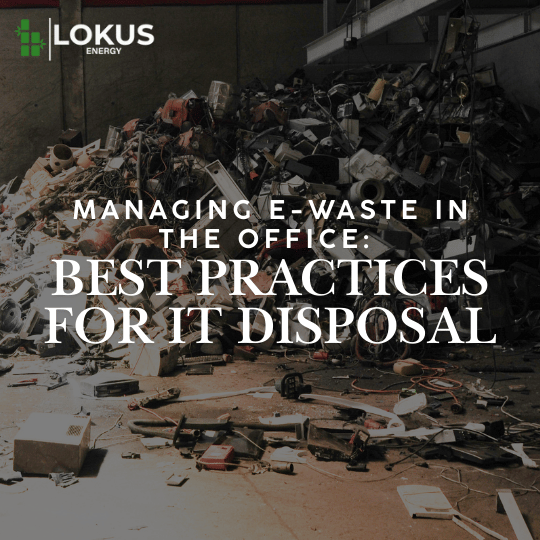Managing E-Waste in the Office: Best Practices for IT Disposal
Proper management of electronic waste (e-waste) is critical for businesses looking to maintain environmental responsibility and data security. Office environments often generate a significant amount of e-waste, including old computers, printers, phones, and other IT equipment. If not disposed of correctly, e-waste can lead to environmental hazards and data breaches. Implementing effective e-waste disposal practices not only helps comply with regulations but also protects the company’s reputation and reduces its environmental footprint.
1. Create an E-Waste Disposal Policy
Establish a clear, company-wide e-waste management policy. This policy should outline procedures for identifying, storing, and disposing of outdated or non-functional IT equipment. The policy should be regularly updated to account for technological advancements and changes in local or international regulations. Employees should be educated on the policy to ensure consistency and compliance.
2. Assess and Audit Your E-Waste Regularly
Conduct periodic audits to identify which IT assets are no longer functional or needed. This will help in effectively planning for disposal, recycling, or reuse. Keep track of equipment’s age, usage, and condition, so you know when it’s time to retire devices safely. Regular assessments will help reduce clutter and ensure that outdated technology is dealt with in a timely manner.
3. Backup and Secure Data Before Disposal
Ensuring data security is paramount when disposing of IT equipment. Before any device is recycled or thrown away, ensure all sensitive data is properly backed up and erased. Simply deleting files or formatting hard drives is not enough—use certified data-wiping tools that follow industry standards to ensure that no data can be recovered from old devices. For added security, consider using physical destruction methods for hard drives, such as shredding or degaussing.
4. Reuse and Donate Functional Equipment
If your equipment is still functional but no longer needed, consider donating it to charities, schools, or non-profits. Many organizations are grateful for the donation of used, working technology. Ensure that the devices are cleaned, refurbished, and wiped of sensitive data before passing them along. Reusing equipment helps reduce e-waste and contributes to community development.
5. Choose Certified E-Waste Recycling Partners
When recycling non-functional equipment, always choose a certified e-waste recycler. Ensure they are compliant with international standards, such as R2 (Responsible Recycling) or e-Stewards certification, which ensure responsible and ethical recycling practices. Certified recyclers follow strict guidelines for disposing of hazardous materials, like lead, mercury, and cadmium, and are required to report their recycling practices and outcomes.
6. Implement a Device Takeback Program
Work with manufacturers or IT service providers that offer a takeback program. Many companies, including those that make phones, laptops, and printers, offer trade-in or takeback programs to recycle or repurpose old equipment. This reduces the responsibility of managing disposal internally and ensures proper recycling.
7. Encourage Employees to Recycle at the Office
Promote awareness of e-waste recycling within the office. Set up designated collection points where employees can drop off obsolete devices such as phones, chargers, and cables. Make it easy for staff to participate by providing clear instructions and visible signage. Incentivize employees by offering small rewards for participation or organizing “E-Waste Day” events.
8. Use Extended Producer Responsibility (EPR) Programs
EPR programs place responsibility on manufacturers for the entire lifecycle of their products, including disposal. If your business regularly purchases new technology, look for suppliers that are committed to EPR programs. This ensures that they will take back and properly recycle their products once they are no longer in use. Supporting such programs can help alleviate some of the e-waste management burden.
9. Manage Batteries and Accessories Separately
Batteries and accessories (like power cords, chargers, and keyboards) often contain hazardous materials that need to be disposed of separately. Many office devices use lithium-ion or alkaline batteries that require special handling. Implement procedures for properly collecting and disposing of these items, and make sure that employees know where to drop off used batteries.
10. Ensure Compliance with Local and Global Regulations
Familiarize yourself with local, national, and international e-waste regulations. Many countries have strict laws governing the disposal of e-waste, including fines for improper disposal. In India, for example, the E-Waste (Management) Rules, 2016 govern the management and disposal of e-waste. Understanding these regulations ensures that your office complies and avoids legal liabilities.
11. Reduce E-Waste Through Sustainable Purchasing
One of the most effective ways to manage e-waste is by reducing it in the first place. Choose energy-efficient, long-lasting IT products that are designed for repair and upgrades. Opt for modular equipment with easily replaceable components, and consider leasing technology instead of purchasing, which can reduce overall e-waste generation when devices are upgraded.
12. Educate Employees on E-Waste Management
Regularly educate employees about the importance of e-waste recycling and proper disposal. Encourage them to keep equipment in good working order for longer, reduce unnecessary upgrades, and follow company policies regarding e-waste disposal. Offering workshops, sending email reminders, or providing informational materials can help foster a culture of environmental responsibility within the organization.
